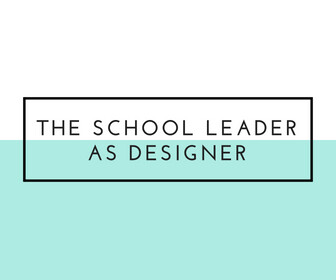“The school day starts when the first child arrives, and it ends when the last child leaves. Everything that happens in between is ultimately our decision as educators.” – Jennifer Sublette
So much of what happens within a school on any given day – as well as when, where, how, and with whom it happens- gets decided by the adults working inside that school’s walls. School leaders have a pivotal responsibility in regard to those decisions. As Peter Senge writes in The Fifth Discipline, a leader serves less as the captain of his or her metaphorical ship and more as its designer. Their choices ultimately shape every system and every structure that guides and governs the form and function of their school.
A driving question for any designer: To what extent are those decisions resulting in users having their needs met? To translate from a leadership perspective: To what extent are leaders’ decisions geared toward meeting the needs of the students and teachers they serve?
Lake Travis ISD (TX) has taken this concept of School Leader As Designer to heart, working together with Advanced Learning Partnerships during the 2017-18 school year to utilize design thinking as the central spine of their site-based administrators’ professional learning. Here’s the story of the leadership team’s first design cycle, focused specifically on understanding, appreciating, and ultimately improving the experiences of the students they serve within their school communities.
Empathy as a Driver for Change
To kick off their first learning cycle, leaders sought to understand the perspectives of specific student populations within their school. Some example drivers of the decisions for focus:
- What is the school experience like for a student for whom English is not their native language?
- What about a student of the mindset that if our school offered 8 AP classes, she would take 9?
- What about a student in the academic middle – neither struggling academically to be targeted for interventions nor achieving such that he gets identified for specific enrichment. How are we serving his needs?
These questions and many others inspired engagement in a Shadow A Student Challenge, in which each principal would commit to spending a school day with a student who fit the criteria of their focus. They would walk the same halls, go to the same classes, even eat the same lunch. Through this experience, leaders would see their schools from their students’ eyes, identifying actions to take that might enhance the student learning experience. That day, every principal committed to taking on the Shadow A Student Challenge over the next three weeks. By the end of the morning’s planning session, some had already lined up a student partner for their Shadow a Student Challenge. One was even invited to start the day by joining the student’s family for breakfast at their home!
The takeaways from investing the time with- and in some ways as– a student in their school opened their eyes to the everyday experiences of learners in their building. One principal even took all of the tests! Some of the key takeaways from their experiences:
- “The academic load was challenging- there was a LOT of work. I am not sure how much was applicable to tangible learning.”
- “Academically, my student struggled to stay engaged in worksheet after worksheet. The only interaction his teachers had with him was to redirect him.”
- “The most glaring moments involved the environment: the furniture we force students to sit in for 90 minutes at a time, the size of our school, and some of the building’s less desirable physical attributes.”
- “Two of the female ESL students didn’t say a word in any of the classes I visited. They looked busy and maybe understood what was going on, but they didn’t say a word.”
- “I was exhausted by the end of the day and have so much admiration for our kids who do this every day, participate in a sport or activity after school, and then do homework!”
Each administrator’s shadowing opportunity inspired new insights into the systems they had designed in service of learning within the school, which drove new opportunities for shifts in practice and gave them ideas for actions to take as a result.
Prototyping Design Solutions
Each site leader committed to testing out one “hack” in their schools – one small change that could impact student experiences for the better. One principal noticed while riding the bus home with her student that a middle school boy across the aisle had pulled out his knitting materials from his book bag during the ride. It led her to try out a “What’s In Your Backpack?” campaign as a way to infuse students’ passions and interests into the school day. Another principal made a commitment alongside her leadership team to welcome every student every day. From bringing students into teachers’ PLCs to creating a learner-led school design team, these hacks focused on honoring student voice to influence school climate and reshape environments for learning. All based on what they learned from their shadowing experience.
Team members used their shared learning space in Schoology to commit to each other to take these action steps. Within the leadership team PL sessions that followed, they shared actions taken toward these “hacks” within their schools, as well as the observed impact. The goal of these sessions was not only to promote follow through on these actionable next steps but also to ensure that each leader had the opportunity to learn about the successes and challenges of their peers.
From Planning to Designing
During the year, principals engaged in several more design cycles, each focused on understanding the experiences of different stakeholders within their school. In one, they partnered with their teachers to design and facilitate authentic learning experiences aligned with the district’s newly emerging learning model. This immersive experience helped them to appreciate teachers’ potential apprehension with taking a risk to try a new approach to instruction and translating into a refinement of their approaches for engaging with teachers to enroll them in this change.
In just a few short months, the principals’ professional learning had been transformed. Each school had suddenly become a space for action research. Each discussion, an opportunity for ideation and iteration. Each meeting, a sea of collaborative innovation. With each learning cycle that followed, these school leaders further developed the mindset of a designer. Their embrace of focusing first on understanding change from the user’s perspective caused the biggest takeaway of all: to recognize that every decision that they make as a leader can ultimately be influenced for the better by first walking in the shoes of those that they serve.
Tony Borash is first and foremost a learner, dedicated to cultivating communities of learners and learning. A former physics teacher, instructional coach, and district administrator in Albemarle County, Virginia, Tony currently serves as the senior education consultant with Advanced Learning Partnerships (@ALPlearn), teaming with K-12 educators across North America to inspire and design shifts that empower learners to own their learning. Connect with him on Twitter at @tborash.








